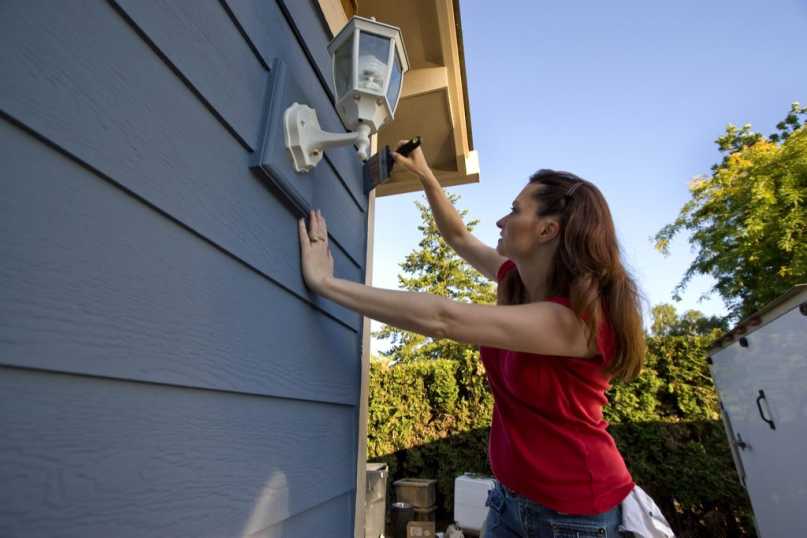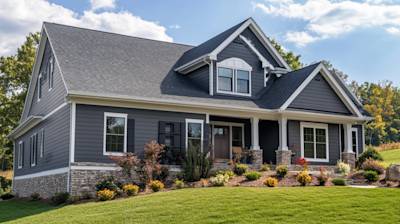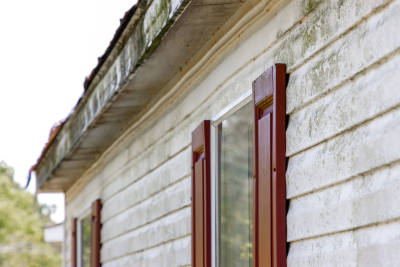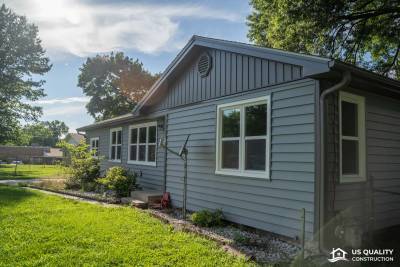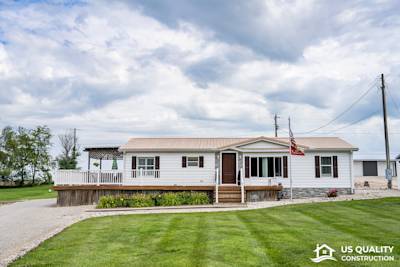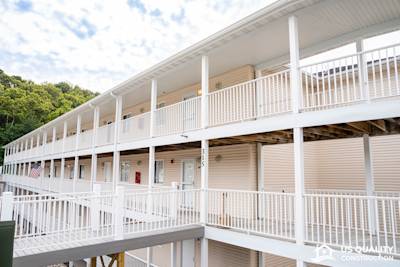Painting Siding
As devoted residents, we go to great lengths to ensure that our home is as attractive as possible. Unfortunately, after years of exposure to the outdoors, our vinyl siding will fade. We're now confronted with a decision: should we paint vinyl siding or replace it?
This article will go through the advantages and disadvantages of painting vs. replacing siding. We'll go through the proper approach to paint vinyl siding as well as the elements that may lead you to replace your siding rather than merely painting it.
Siding Replacement Vs. Painting Old Vinyl Siding
Changing the color of your siding is one of the easiest ways to alter the look of your home. Should you, however, paint vinyl siding or simply replace it? Both have their advantages. There are reasons why you shouldn't paint vinyl siding and why you shouldn't replace it.
Painting vs. replacing can be a stressful decision for homeowners who want to do the right thing for their houses and wallets. Fortunately, we're here to assist you in making the best selection possible, depending on your specific circumstances. We'll go over the numerous reasons you should paint vinyl siding rather than replace it in the sections below. You'll also learn why painting your siding is a bad idea and why returning it is the best option.
Consider These Factors before Painting or Replacing Your Vinyl Siding
You could have your sight on a modern vinyl siding product, but you're also thinking of repainting your current siding to save money.
Take into account the following:
- The age of the siding: A fresh coat of paint may make it appear newer, but the real question is whether the siding is safeguarding your property. If your siding is more than 20 years old, consider replacing it rather than painting it because it will most likely need to be returned in the next five years or so. A siding contractor may evaluate your siding to identify its age and quality, as well as suggest future steps.
- Cost of painting vs. replacing: To paint vinyl siding makes more sense in some situations. If your siding is in good shape and you want a bespoke color that siding manufacturers don't make, painting vinyl siding would be a better option because you'll obtain the color you want while saving money.
- Condition: It's time to replace it if buckles, gaps, or moisture are getting through. You shouldn't paint vinyl siding that has rotten portions, dents, or holes because it's pointless to invest money in something that is already crumbling.
- Attractiveness: If you opt to paint vinyl siding, you'll give it a fresh new look that will appeal to not just you but also those around you. The same can be said for new siding - it has a pleasing aesthetic that will make others envy.
- Preserve or raise the value of your home: A new coat of paint on your siding could enhance the value of your property by two to five percent. According to most estimates, if you replace your siding to try to obtain more money out of your home sale, you'll only recoup about 80% of your spending. However, what hasn't been considered is the curb appeal that attracts purchasers to your home. Would they have offered the same price if the existing siding had stayed on the house?
- Warranty: Most siding contractors will only work with manufacturers who warranty their products. Warranties vary, so make sure you do your study if you opt to replace rather than paint vinyl siding. However, be aware that most manufacturers will void the warranty if you paint over siding.
If you have any remaining concerns, see a siding contractor and arrange an inspection. That will assist you in making a fact-based judgment on the next measures you should explore.
Why Is It Necessary to Paint Vinyl Siding?
Siding will not retain its original luster indefinitely. The siding's protective covering will eventually wear away. It will fade with exposure to the sun, and filth will accumulate with time. You know you'll have to paint vinyl siding or replace it at some point shortly because power cleaning only works for a certain amount of time.
Let's say you don't have the funds to replace your siding right now, but you know that applying a layer of paint to your existing siding will restore its luster. If you're sure, the siding is still in good order.
Affordability
When you paint vinyl siding, it will help you save almost 50%-60% compared to replacing it.
Aesthetics
To paint vinyl siding with a weathered appearance will improve its attractiveness, restoring it to a near-factory appearance in some situations.
Layer of protection
When the protective layer on your siding fades off, you'll need something to replace it and keep your property protected from the weather, and paint will do the trick.
Boost the value of your home
Don't be surprised if the appraiser offers you bonus points if you have a fresh coat to paint vinyl siding.
A new appearance
The painting will get you to a new hue that's trending if you've gotten tired of the color that's been on your home for years and wants to change it up.
Longer life expectancy
You may extend the life of your siding by adding a layer of protection, no matter what type it is.
Time savings on the project
You should expect a multi-day project if you're removing and replacing siding on your home. When you paint vinyl siding, it takes a fraction of the time.
Painting your siding may be the ideal option for you if you can benefit from one or more of these advantages.
Top Reasons to Replace Vinyl Siding Instead of Painting It
You've most likely heard or read that painting your siding is not a good idea. If it appears to be worn, the information provider will advise that it is time to replace it. That is likely to be the path taken by individuals with sufficient financial resources. However, if you have some damaged siding that needs to be replaced, painting it will merely delay the inevitable and likely increase the entire project cost.
You should also consider that siding manufacturers have increased their textures and colors in recent years, so painting may not be the most excellent option if you want a new look, as there are many more varieties of siding available now that will please you far more than a paint job. Perhaps you'd like to add scallops for a fresh look or an underlayment to help with energy efficiency - these are things you can do with siding replacement that you won't be able to do with painting.
Here Are Some More Things To Think About:
- If painting your siding will lose your warranty (many manufacturers state that "changing" the siding will void the warranty), you should think about replacing it instead of painting.
- Paint isn't as long-lasting as new siding, which is another consideration when making your final decision. Also, due to weather conditions, you can only paint your home's exterior during specific months of the year.
- Consider whether or not you are confident that the paint you intend to use will genuinely work on your siding. Some forms of siding will not adequately absorb the paint, and some paints will not adhere to certain types of siding when applied. If you've chosen a color that you like but isn't compatible with the sort of siding you have, you're in for a disappointment.
- When you prepare the siding for painting, you want to make sure that all of the dirt and grime are removed from it. That means that you'll most likely use a power washer, mainly responsible for damaging siding. You're also prone to get moisture trapped below your siding, which can cause structural damage to your property as well as a mess of your paintwork in the process.
- Since the siding manufacturer will most likely not have siding available in the color, you selected, replacing damaged panels will be more difficult in the future.
- Painting is more error-prone than siding replacement because of the greater amount of surface area to cover. Generally speaking, the mistakes you make when the painting is deemed "unforgiving," which is not something you'll have to worry about when hiring a siding contractor to install new siding on your home professionally.
- When you paint vinyl siding, the unpredictable nature of the process is also present. It's usually a coin toss when it comes to deciding what the final result will look like.
The painting appears to be less risky than other art forms, yet history has shown that this is not the case. When it comes to painting, everything has to be suitable – from the weather to the cleanliness of the siding to the sort of paint you use. What's more definite is that when you replace your siding, you will notice benefits that will leave you with no regrets about your decision.
How to Paint Vinyl Siding: A Step-by-Step Guide
So, when you've done the calculations and determined that the best option is to paint vinyl siding, what are the next steps?
Please bear in mind that your siding is designed to keep moisture out of your home, and it is also constructed in such a way that water may simply slide off the surface. The trouble is that if you're not careful, your paint could end up doing the same thing as the water.
Vinyl paint is ideal because water-based paints do not adhere to vinyl siding and acrylic paints. Vinyl paint manufactured with acrylic and urethane resins sticks to siding more readily, but you may still need to apply more than two coats if the siding is very old or very dirty.
Step-by-step instructions:
Step 1: Make sure that the siding is in good condition before proceeding to paint vinyl siding
Before you decide to spend the money on a large quantity of paint, hire a professional siding contractor to come out and check your siding before you make any decisions. While today's materials will not bow under the intense summer heat of yesterday's materials, there is still a possibility that high winds, rain, and debris have undermined the integrity of the material, necessitating the need for repair or replacement of the material.
If you've accidentally bumped your house too many times with your lawnmower or snow blower, you may notice cracks appearing that allow moisture to seep into your property. While vinyl siding is durable, it is not impervious to damage. Therefore extra steps should be taken to guarantee that the quality remains intact.
Step 2: Prepping and cleaning the siding
Remove all dirt and grime from the siding by washing it thoroughly. That will prevent the paint from looking dreadful and finally peeling off. A commercial home and siding cleaner, such as Clorox House & Siding, is available for purchase, or you can make your cleaning solution.
The most popular cleaning solutions are 70% water and 30% white vinegar. Another method is to mix one cup of powdered oxygen bleach with five gallons of warm water and let it sit for 15 minutes. Work the solution into the skin with a soft-bristled brush or a towel, and then rinse it off well afterward.
Step 3: Determine whether or not you require priming
Is it necessary to use a priming coat? It is essential to prime the vinyl before painting it if your paint is significantly different from the original hue. Furthermore, if the color you intend to use does not have a good match with your siding, you may need to prime your siding first before painting.
Step 4: Choosing your paint
Choose the appropriate paint color. Consult with the manufacturer to ensure that the paint will work with the installed type of siding. Keep in mind that the paint you'll be using will contain acrylic and urethane resins, which will assist it in adhering to the siding more effectively.
Another suggestion is to use paint that is the same shade or lighter than your existing siding color.
Lastly, picking a dark hue can cause you to attract more heat, which is not something you want during the sweltering months of summer!
Step 5: Choosing a color scheme
The color you choose is mostly a matter of personal preference, but you should keep in mind that if you ever need to replace damaged siding, your manufacturer may not have it in the color you want to use again.
Dark colors, once again, will draw heat, which will be unwelcome throughout the warmer months. It is typically recommended to choose lighter paints because they will be closer in tone to your existing siding, which will reduce the number of coats you will need to apply.
Step 6: Applying the paint
Making unforgivable mistakes while painting your home is more complicated than it appears, and it can cost you more money in the long term if you don't do it correctly.
Make an informed decision when hiring a painting contractor. If your siding has pits in it, you'll want to use a primer to smooth out the defects and make them less noticeable. To ensure even and thin application, apply the paint in light coats initially, and then go over it again with thicker applications once the first coat has dried. Your paint should last approximately ten years after application if you have done an excellent job.
Step 7: Preventative Maintenance
In addition, there is the matter of upkeep. Once the paint is applied and the area has been well cleaned, you'll need to keep an eye on it and touch it up as necessary. Cleansing the siding at least yearly is also a wise decision because it can help extend the paint's lifespan.
Vinyl Siding Replacement from US Quality Construction Is a Wise Choice
At US Quality Construction, we work with various siding materials, with vinyl being one of the most common. Fortunately, the siding manufacturers from whom we obtain our siding provide a superb product that will last for years and years to come.
Our selection of new vinyl siding will improve the appearance and feel of your home while also increasing its curb appeal when a paint job simply won't do. Contact us today to learn more.
As siding experts, we at US Quality Construction collaborate with some of the most reputable siding manufacturers. Modern engineering has increased the quality of vinyl siding. Our years of experience installing it have earned us the reputation of being the go-to contractor for siding replacement projects around the area.
Aside from the fact that we offer a quick installation and a low cost, we also have a large selection of vinyl siding colors and styles that appeal to homeowners. In addition to being affordable and long-lasting, vinyl siding is also aesthetically pleasing to look at. However, if it is not installed correctly, none will be used.
To learn more about your options, please get in touch with us today!
Tags: painting vinyl siding, paint vinyl siding,


